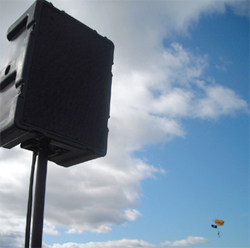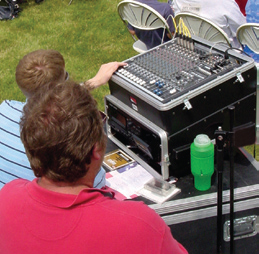
As previously noted, some power amplifiers now also offer built-in DSP, and these packages are increasingly competitive from a price standpoint.
The digital processing can serve as a substitute for active crossovers and delays.
Crossover-filter presets for specific loudspeakers can make it a snap to set up a multi-way system.
High-pass filters prevent harm to loudspeakers, often due to powerful lows in music, mic-stand thumps or accidental DC at the amp output.
Mixers. Self-powered or not? A mixer that incorporates power amplification is usually easier to carry and set up – it’s more plug and play.
An increasing number of powered mixers also include onboard effects, and some offer a graphic equalizer, which is useful for tuning the frequency response of the loudspeakers in different environments.
An advantage of a separate mixer and power amp is that if either one fails, only one component needs to be replaced.
Stand-alone mixers also tend to be more ergonomic for the user, and there are more size options – no need to purchase a unit with 8 channels if the maximum number of channels needed isn’t going to exceed 4 or 5.
Be sure that the mixer has enough balanced XLR mic inputs to handle any possible application you have in mind for the system. RCA jacks for CD and MP3 players come in handy.
Loudspeakers. Full-range loudspeakers for portable PA are usually 2-way designs, either powered or passive. Most applications require just two loudspeakers, but there may be times when additional loudspeakers are needed.
Flexible connectivity is something to keep in mind.
For example, the latest generation of JBL EON portable loudspeakers have an XLR output where the output signal is selectable, either the whole mix may be looped to another loudspeaker (or sent to a mixing console), or simply the primary input for traditional “daisy-chaining” of additional loudspeakers.
These also offer one XLR/ quarter-inch combo connector and additional quarter-inch inputs providing input flexibility and the ability to mix multiple sources.
Some applications may require a stage monitor or two, in addition to two or more main/full-range loudspeakers. An increasing number of portable cabinets offer a side that angles the drivers more steeply upward toward the performers.
Typically, full-range loudspeakers are available with a choice of 12-inch or 15-inch cone woofer that is ported, joined by a driver on a horn or waveguide.
Horn dispersion (6 dB-down points) is commonly 40 degrees vertical x 90 degrees horizontal, or 40 degrees vertical x 120 degrees horizontal, but again, we see an increasing variety of coverage patterns available.
Keep in mind that the overall goal is to focus as much direct sound on the audience (and off of surrounding hard surfaces). Thus the polar pattern is important, particularly for indoor applications and especially in highly reverberant spaces like gymnasiums and some worship sanctuaries.


